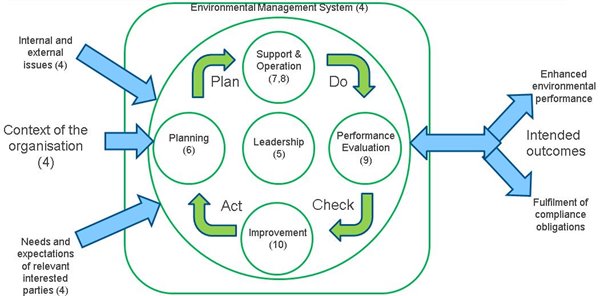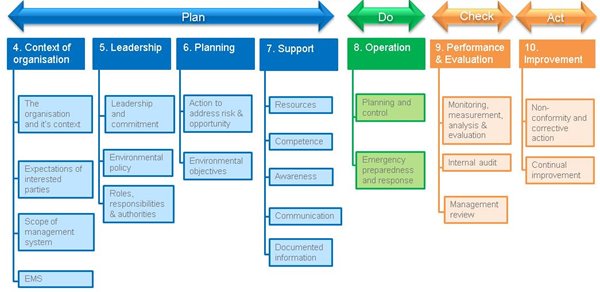How to Enhance Environmental Performance with ISO 14001
The pressure on organizations to improve their environmental performance is stronger than ever. With recent environmental disasters and freak weather hitting the headlines, climate change is in focus. As a result, Governments are creating more environmental regulation, pressure groups are more vocal and consumers more aware of the environmental impacts of their choices and who they buy from.
This translates directly into pressure on organizations to not only protect the environment, but to enhance their environmental performance. The international standard ISO 14001 directly addresses this need and enables organizations to improve performance and prove their environmental credentials to key stakeholders.
This blog will answer the following questions:
1. What is Environmental Performance?
2. How does ISO 14001 = Enhanced Environmental Performance?
3. What is the EMS Performance Improvement Cycle?
4. What is the relationship between PDCA and ISO 14001 Clauses?
5. In Summary, how do I Improve Environmental Performance?
Introduction:
ISO 14001:2015 specifies the actual requirements of an Environmental Management Systems (EMS). It provides a generic framework for planning, implementing and improving an EMS and has become an essential reference for environmental improvement for thousands of organizations.
It is applicable to any organization, regardless of sector or activity, that’s interested in establishing, implementing, maintaining or improving an EMS for the goal of enhancing environmental performance and the related benefits that can be gained.
Certification to ISO 14001 provides independent recognition of compliance with the standard and over 324,000 certificates have been issued globally. This makes ISO 14001 the second most certified standard next to ISO 9001 for quality management systems.
1) What is Environmental Performance?
Before we can embark on a quest to improve environmental performance, it is essential to grasp the key concepts that constitute environmental management.
ISO 14001:2015 does not directly define environmental management. However, it does contain all of the definitions required to interpret the standard and its specific requirements. Over thirty terms and definitions are presented in section three of the standard and these are essential reading if you intend to achieve enhanced environmental performance.
Highlighted definitions relating to and constituting environmental management are:
-
Environment. As Einstein said “the environment is anything that isn’t me” and ISO 14001 refers to the environment as the surroundings in which an organization operates. This includes air, water, land, natural resources, flora, fauna, humans and their interrelationships.
-
Environmental aspect. This can be any element of an organization’s activities, products or services that interacts or can interact with the environment. Aspect can vary widely depending on the specific organization but commonly include the use of energy, generation of waste and emissions to air, land and water.
-
Environmental impact. The result of a positive or negative change to the environment caused wholly or partially from an organization’s environmental aspects.
-
Environmental management system (EMS). This is part of the organizations management system used to:
-
manage environmental aspects and their interaction with the environment
-
fulfill compliance obligations, which may be voluntary or mandatory
-
address risks from internal and external sources and opportunities arising to enhance environmental performance
-
-
Environmental performance. Performance related to the management of environmental aspects.
The final two definitions are the main focus and purpose of ISO 14001. They are good starting references for top management to set environmental policy, which should focus on enhancing environmental performance by protecting the environment by preventing, mitigating and reversing negative impacts.
2) How does ISO 14001 = enhanced environmental performance?
As previously stated, the overall aim of ISO 14001 is to provide an environmental management systems framework that helps organisations to enhance their environmental performance, fulfil related compliance obligations and achieve environmental objectives.
Although there are other ways to implement an environmental management policy, ISO 14001:2015 is an extremely popular and effective way to do so. It provides an internationally recognized framework developed over two decades with the input of hundreds technical experts and feedback from users in commercial, non-profit and governmental organizations.
So, implementation of an ISO 14001 compliant EMS is a principal method of improving environmental performance. It takes a holistic view and aligns initiatives, which is more effective and sustainable in the long term than ad-hoc projects.
3) What is the EMS Performance Improvement Cycle?
The foundation of ISO management system standards is the Plan-Do-Check-Act (PDCA) cycle, made famous by W. Edwards Deming [a.k.a. The Deming Cycle].
ISO 14001 uses PDCA as the basis for continual improvement of the EMS and enhanced environmental performance. The diagram below shows how the ISO 14001 requirements (clause numbers) align and interact with stages of PDCA.

4) What is the relationship between PDCA and ISO 14001 Clauses?
The adapted PDCA below demonstrates the relationship between the clauses of ISO 14001. You’ll see that it doesn’t include Clauses 1-3 as these are the terms of reference for the documented standard.
Clauses 4-10 are considered to be the actual and auditable requirements of ISO 14001 that must be implemented as part of an EMS.

Implementation of an EMS can broadly follow the linear version of the PDCA as follows:
-
Plan = strategic planning. This is a strategic stage that involves assessing the context of the organization with tools like PESTLE and SWOT, defining leadership roles and responsibilities and setting environmental policy. This leads into impact environmental impact assessment (EIA) and the setting of specific environmental objectives. This should be supported with the appropriate financial, physical and human resources to achieve objectives.
-
Do = operational implementation. This stage moves from strategy to operational environmental management and focuses on establishing the specific processes, procedures and controls of the EMS. It also includes specific preparations for emergencies, which will vary depending upon the context of the organization. Emergency preparedness may also cross-over with health and safety procedures depending on the context of the organization.
-
Check = performance evaluation. Monitoring, measurement, analysis and evaluation of performance must be undertaken at planned intervals to ensure the EMS is achieving its objectives and to identify opportunities for improvement. Key activities to support this are internal auditing and management review, which should also be planned documented.
-
Act = improvement. The outputs of performance evaluation must be acted on and ISO 14001 explicitly requires continual improvement. This requirement brings the focus of the EMS back to enhancing environmental performance, which could be based on corrective action or opportunities for improvement.
5) In Summary, how do I improve environmental performance?
In summary, improving or enhancing environmental performance is best achieved through the implementation of an ISO 14001 compliant management system. This will ensure that the motivation to improve performance not only has commitment but also the resources, infrastructure and framework to act on that commitment in a sustainable and systematic fashion.
This may seem like an oblique high level answer to the question of improving or enhancing performance. However it sets the foundation for your case of implementing an EMS. It also sets the scene for future articles that will address practical issues and specific tools to help you to plan, implement and optimize an EMS.
For more information about Environmental Management Systems
-
Start at the beginning – check out our ISO 14001:2015 Essentials eLearning
-
Build your skills – see our environmental management training
-
Plan your budget – get a quick quote for EMS certification
-
Upgrade your EMS – follow our guidance on the transition to ISO 14001:2015
